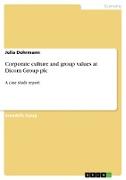- Start
- Corporate culture and group values at Dicom Group plc
Corporate culture and group values at Dicom Group plc
Angebote / Angebote:
Scientific Essay from the year 2008 in the subject Business economics - Business Management, Corporate Governance, grade: Distinction, University of Western Sydney (School of Management ), course: Human Resource Strategy, 10 entries in the bibliography, language: English, abstract: The organisational culture as a complex and multilayer concept and embraces regarding to Cameron and Quinn "...the taken-for-granted values, underlying assumptions, expectations, collective memories and definitions present in an organisation" (2006, p. 16). Regarding to Lasher (1999) the term of organisational culture describes the general operating mode and the character of an organisation. Further the organisational culture is often distinguished between the external visible and the hidden section (Lewis, 1998). The culture of an organisation becomes visibly manifested in its lived politics, processes, symbols and behaviours. While the emotions, beliefs and values of organisational members as well as the fundamental basic assumptions respectively the 'Paradigm' in the inner core of an organisation cause the hidden part of an organisational culture (Lewis, 1998). The employees take an outstanding position. They mark and affect the organisational culture and develop it to an organisation with a unique character. In this respect HRM is of substantial importance for the perceived culture.
In their 'Cultural Web' concept Johnson, Scholes and Whittington (2005) focused on the extrinsic observable elements of an organisational culture and factored out the abstract and hidden cultural part of emotions, beliefs and values. The 'Cultural Web' represents the organisational assumptions - which are taken for granted and become manifest in the everyday behaviour of the organisational members - in six dimensions of cultural artefacts. Each dimension describes a certain aspect of the operating mode and behaviour in an organisation. The subsequent figure shows the 'Cultural Web' respectively the six manifest dimensions of the organisational 'Paradigm' of the Dicom Group plc. The artefacts can be attributed fundamentally to the technical, political or cultural subsystems of an organisation (Balogun and Hope Hailey, 2004)...
Folgt in ca. 10 Arbeitstagen




